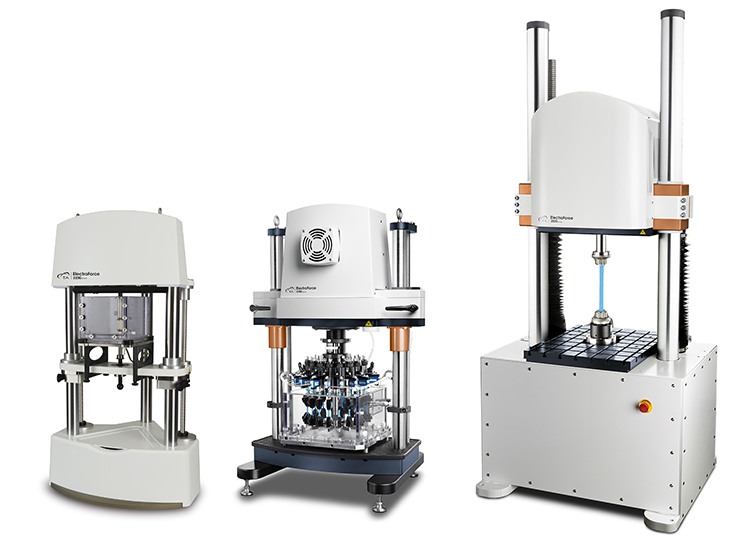Medical Device Material Durability Testing
How Fatigue Testing Makes More Reliable Devices
Troy Nickel | Morgan Ulrich
February 03, 2023
Do your patients worry about their replacement hip breaking when they run? Or how long their prosthetic leg will last before needing a new one? Are your regulatory submissions requiring increasingly more lifetime testing?
What is medical device durability testing?

What are durability test methods?
Test loading is often repetitively applied through two test methodologies:
Testing to success
For example, testing to success can confirm that implants do not fail when subjected to physiological levels for 10 million cycles, approximating 10 years of lifetime of walking and running.
Fatigue to fracture
Fatigue to fracture (FtF) involves understanding where a device’s weakest component lies by pushing it past its failure limits with a larger loading magnitude. This approach is often used earlier during device development because the insights it provides contribute to refining the device’s final design. Fatigue to fracture results are increasingly leveraged in regulatory submissions because they provide even stronger evidence of reliability and a more rigorous assessment of safety margins.
For example, perhaps you’d test implants at 2x physiological levels to determine how and when they fail, then 2.5x or 1.5x to understand how the lifetime decreases or increases with a change in loading levels. This method is repeated at many levels with many samples to obtain higher and higher confidence in the relationship between load levels and lifetime of implants.
Medical Device Fatigue Testing Systems
As explained above, designing new medical device materials and products requires a thorough assessment of material properties and complete performance evaluation within, and sometimes beyond, the intended end-use. Flexible and robust instruments enable accurate and timely execution of device-specific testing standards and rigorous performance evaluation for orthopedic device testing.
ElectroForce technologies have revolutionized the way material testing is performed. Proven for ultra-reliable fatigue and durability testing, these instruments are a staple in medical device labs around the world.
Which instrument is right for my lab?
Choosing an instrument for your medical device testing requires you first get clear on your needs:
- Am I testing to success or fatigue to fracture? Or both?
- What force will my materials or devices have to withstand? What displacement?
- What environment will my devices perform in? I.e., in air, in fluid, at temperature, etc.
The ElectroForce family of load frame test instruments include a full range of force and performance capabilities for various applications. The most common models for medical device testing include the ElectroForce 3200, ElectroForce 3300, ElectroForce 3500, and Multi Specimen Fatigue Instruments. See which one aligns with your needs in the chart below.
| ElectroForce 3200 | ElectroForce 3300 | ElectroForce 3500 | MSF 6 | MSF 16 | |
|---|---|---|---|---|---|
| Number of Specimens | 1 | 1 | 1 | 6 | 16 |
| Force range (per sample) | 0.002 to 450 N | 0.02 to 3000 N | 1 to 15,000 N | 0.005 to 225 N | 0.005 to 100 N |
| Displacement | 0.002 to 13 mm 163mm optional |
0.005 to 25 mm, 175 mm optional |
0.005 to 50 mm | 0.005 to 25 mm, 175 mm optional |
0.005 to 25 mm |
| Maximum Fatigue Frequency | 300 Hz | 100 Hz | 100 Hz | 100 Hz | 100 Hz |
ElectroForce Load Frame Instruments
TA ElectroForce® test instruments feature proprietary ElectroForce linear motion technologies coupled with advanced controls and analysis software. Driven by friction-free electromagnetic motors, they provide a revolutionary approach to mechanical fatigue and dynamic characterization. They are also very lab-friendly thanks to their clean and maintenance-free operation. As a result, they have set a new standard for performance, reliability, and versatility in a single test instrument.
ElectroForce 3200, 3300 and 3500 Load Frames
This family of load frames is highly flexible, offering multiple loading ranges and frame configurations. They each leverage a high-performance friction motor specific for its force range, HADS sensors, plus flexible and convenient frame features that make them perfectly suitable instruments for accelerated testing of many materials, components, and devices.
Electroforce™ Multi-Specimen Fatigue Instruments
The MSF instruments are built from the powerful and dynamic 3300 load frame to increase fatigue throughput by testing multiple specimens simultaneously. Each sample experiences the same applied displacement, e.g. 1mm at 30Hz, but have individual force sensors to monitor the force decay or failure of each specimen. These instruments are especially useful in high cycle fatigue programs of flexible materials or devices, where each specimen can take days, weeks, or even months to fail. This approach can substantially increase your throughput and improve time to market.
ElectroForce 3300 6-Specimen MSF Instrument
MSF6 increases sample throughput by simultaneously testing 6 samples at up to 225N each. It is popular for flexible polymers, elastomers or more flexible metals or structures. MSF6 can also be mounted and operated within an oven to give you a greater understanding of how devices or device materials perform at various temperatures, such as your prosthetic foot in the Minnesota winter or Texas summer.
ElectroForce 3300 16-Specimen MSF Instrument
MSF16 provides an unmatched capacity of 16 specimens with up to 100N each. The optimized design provides greater sample access and visibility for simplified sample loading and viewing. It includes a 37 °C Fluid Bath and is widely used for small device or fatigue of metals such as Nitinol and other tailored Shape Memory Alloys (SMAs).
ElectroForce Load Frames and Multi-Specimen Fatigue are industry-leading medical device durability testing instruments.
Find out more about TA Instruments’ industry-leading medical device durability testing. TA Instruments also offers a number of other test instruments that are useful in characterizing materials and processes used to deliver medical devices.

